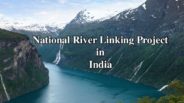To curb floods & droughts, government finally approves ‘River Linking Project of India.’

For centuries India struggles every year in monsoon season when floods devastate country. Every year, floods make thousands of people homeless, starve people, destroy crops and agriculture lands and other destructive effects. With every year floods uncontrollably damaging natural resources and human habitats, one question always arises in our minds – Isn’t it controllable? India is blessed with ample water resources but due to lack of effective water management system, country faces heavy floods in peak rains season and severe drought conditions in peak summers. Now government has given final approval to long pending and ambitious ‘River Linking Project.

After years of foot-dragging India will begin work in around a month on an $87 billion (Rs. 5,55,593 crore) scheme to connect some of the country’s biggest rivers. The ambitious project to end deadly floods and droughts was kick started by Prime Minister Narendra Modi.
The mammoth plan entails linking nearly 60 rivers, including the mighty Ganges, which the government hopes will cut farmers’ dependence on fickle monsoon rains by bringing millions of hectares of cultivatable land under irrigation.
In recent weeks, some parts of India and neighbouring Bangladesh and Nepal have been hit by the worst monsoon floods in years, following two years of poor rainfall. Government has pushed through clearances for the first phase of the project – which would also generate thousands of megawatts of electricity – the sources say, despite opposition from environmentalists, tiger lovers and a former royal family.
The project will involve construction of a dam on the Ken river, also known as the Karnavati, in north-central India and a 22-km (14-mile) canal connecting it to the shallow Betwa. Both rivers flow through vast swathes of Uttar Pradesh and Madhya Pradesh and the prime minister hopes the Ken-Betwa scheme will set a template for other proposed river interlinking projects.
The project has got clearances in record time, with the last round of clearances coming in only this year. Government officials say diverting water from bounteous rivers such as the Ganges, Godavari and Mahanadi to sparse waterways by building a clutch of dams and a network of canals is the only solution to floods and droughts.
But some experts say India would be better off investing in water conservation and better farm practices. Environmentalists and wildlife enthusiasts have also warned of ecological damage. The 425-km (265-mile) Ken flows through a tiger reserve nestled in a verdant valley. The government plans to clear out 6.5 percent of the forest reserve to build the dam, relocating nearly 2,000 families from 10 remote villages.
Around half a dozen clearances, including on environmental and forest protection, have been obtained for the scheme to link the Ken and Betwa. The government is also finishing up paperwork on projects in western India linking the Par-Tapi with the Narmada and the Daman Ganga with the Pinjal. The projects involve state of Gujarat and neighbouring Maharashtra.
The river-linking projects was first proposed in 2002 by the last BJP-led government. Work stalled because state governments sparred over water sharing contracts and clearances got stuck in India’s notoriously snail moving bureaucracy.
India, which has 18 percent of the world’s population but only 4 percent of the usable water resources, perversely gives incentives to produce and export thirsty crops such as rice and sugar cane.
Some environmentalists have raised concern over this project as building dam in forest areas will reduce natural habitats of tigers and endangered vultures in Panna reserviours and adjoining areas will pose a threat of floods. Government is counting benefits of project whereas environmentalist tell the drawbacks & threats.

 Currency Convertor
Currency Convertor Post an article
Post an article eLive Today
eLive Today

 sending...
sending...




